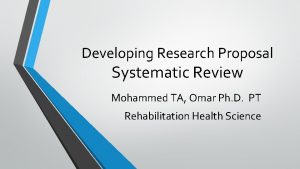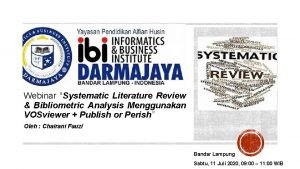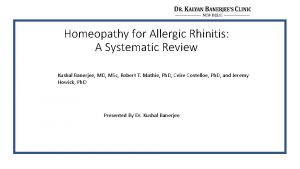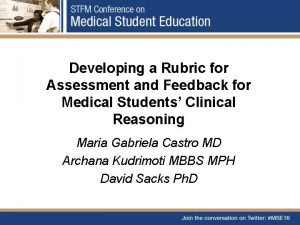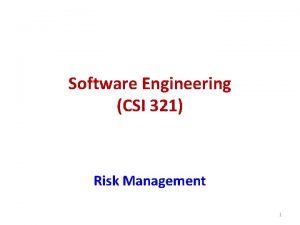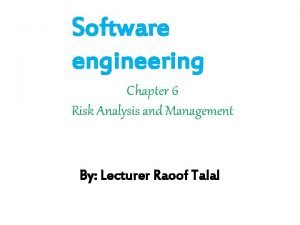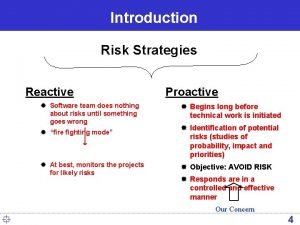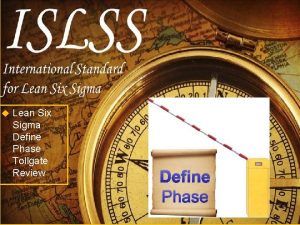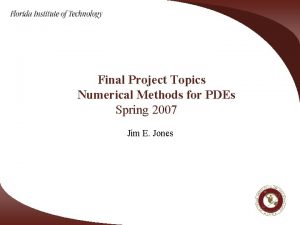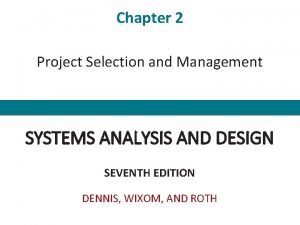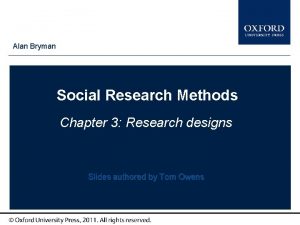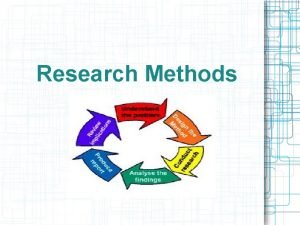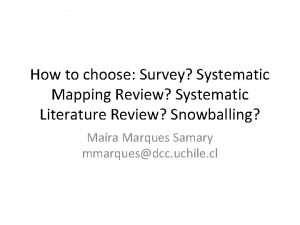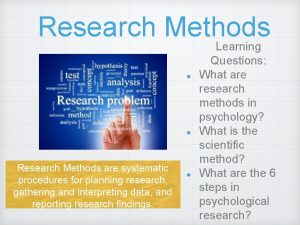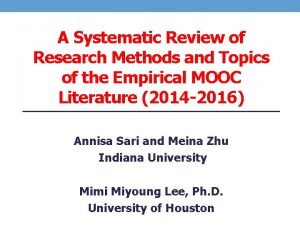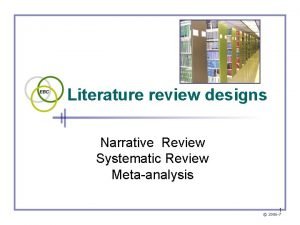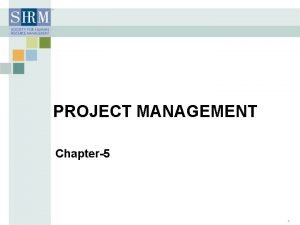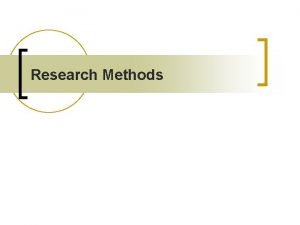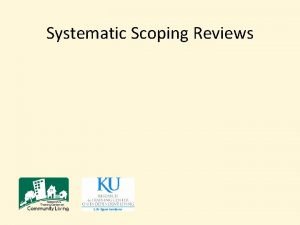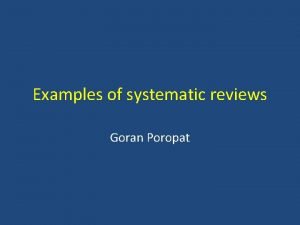Research Methods Project Management Systematic review as a




































- Slides: 36

Research Methods & Project Management Systematic review as a research method M. Tsiknakis Postgraduate Course on “Informatics and Multimedia”, Fall 2020

Context v "Indeed, one of my major complaints about the computer field is that whereas Newton could say, "If I have seen a little farther than others, it is because I have stood on the shoulders of giants, " I am forced to say, "Today we stand on each other's feet. " v Perhaps the central problem we face in all of computer science is how we are to get to the situation where we build on top of the work of others rather than redoing so much of it in a trivially different way. Science is supposed to be cumulative, not almost endless duplication of the same kind of things". Richard Hamming 1968 Turing Award Lecture

What is a systematic review? “Systematic literature review (also referred to as a systematic review). A form of secondary study that uses a well-defined methodology to identify, analyse and interpret all available evidence related to a specific research question in a way that is unbiased and (to a degree) repeatable. ” (Individual studies contributing to a systematic review are called primary studies; a systematic review is a form a secondary study). ”* B. A. Kitchenham, “Procedures for Performing Systematic Reviews, ” Technical Report TR/SE-0401, Keele University, and Technical Report 0400011 T. 1, NICTA, 2004. *

Advantages v The advantages of systematic literature reviews are that: § The well-defined methodology makes it less likely that the results of the literature are biased üalthough it does not protect against publication bias in the primary studies. § If studies give consistent results, systematic reviews provide evidence that the phenomenon is robust and transferable. § If the studies give inconsistent results, sources of variation can be studied.

Publication bias v Publication bias is a type of bias that occurs in published academic research. v It occurs when the outcome of an experiment or research study influences the decision whether to publish or otherwise distribute it. v Publication bias refers to a phenomenon in scientific reporting whereby § authors are more likely to submit and § journal editors are more likely to publish studies with “positive” results (i. e. results showing a significant finding) than studies with “negative” or unsupportive results.

Advantages & Disadvantages v In the case of quantitative studies, it is possible to combine data using meta-analytic techniques. v This increases the likelihood of detecting real effects that individual smaller studies are unable to detect. v The major disadvantage of systematic literature reviews is that they require considerably more effort than traditional literature reviews.

Reasons for performing a SR v Reasons for a systematic review. • To summarize the existing evidence concerning a given topic or technology. • To identify any gaps in current research in order to suggest areas for further investigation. • To provide a framework/ background in order to appropriately position new research activities. Research Results

The Importance of systematic reviews v Most research in a new area starts with a literature review. v To have scientific value, a literature review must be thorough and fair/unbiased. Systematic reviews v A review protocol that specifies the research question being addressed. v In accordance with a predefined search strategy that aims to detect as much of the relevant literature as possible.

Systematic Review Protocol v A systematic review protocol describes § the rationale, hypothesis/research question, and planned methods of the review. v It should § be prepared before a review is started § used as a guide to carry out the review and § made publicly available.

Components of the review protocol v Background. The rationale for the survey; v The (research) questions that the review is intended to answer; v The strategy that will be used to search for primary studies including search terms and resources to be searched (databases, specific journals, and conference proceedings); v Primary study selection criteria determine criteria for including in, or excluding a study from the review; v Data extraction strategy. This should define how the information required from each primary study would be obtained; v Synthesis of the extracted data. This should define the synthesis strategy.

Conducting the review Identification of research v Find as many primary studies related to the research question as possible using an unbiased search strategy. v For example, it is necessary to avoid language bias. § Publication bias refers to the problem that positive results are more likely to be published than negative results.

Conducting the review Study selection v Study selection criteria are intended to identify those primary studies that provide direct evidence about the research question. q In order to reduce the likelihood of bias, selection criteria should be decided during the protocol definition.

Conducting the review Data Extraction - Analysis v Design the data extraction forms to accurately collect all the information needed to address the review questions and the study quality criteria. § § Title, authors, journal etc. Date of data extraction Questions needed to be answered Additional notes

Conducting the review Data synthesis v Extracted information about the studies should be tabulated in a manner consistent with the review question. v Tables should be structured to highlight similarities and difference between study outcomes. v Study outcomes must be presented in a comparable way. § Binary: yes/ no § Numerical measures: Mean difference, etc.

Reporting the review 1/4 v Journal or thesis ? v Title v Authors v Executive summary or structured abstract § § § Context/Background (importance of the search) Objectives (questions addressed) Methods (data sources, study selection etc. ) Results (main findings) Conclusions (implications for future research) v Background

Reporting the review 2/4 v Review questions v Review methods § § § Data sources and search strategy Study selection Study quality assessment Data extraction Data synthesis v Results: § Description/ classification of primary studies § Results of any quantitative summaries

Reporting the review 3/4 v Discussion § Principal findings üThese must correspond to the findings discussed in the results section § Strengths and Weaknesses üStrength and weaknesses of the evidence included in the review. Relation to other reviews, particularly considering any differences in quality and results. § Meaning of findings üDirection and magnitude of effect observed in summarised studies applicability/ generalizability of the findings.

Reporting the review 4/4 v Conclusions ü Recommendation ü Practical implications for the research ü Unanswered/new questions for the future v Acknowledgements v Conflict of interest v References and appendices

Example A. Pampouchidou, Automatic Assessment of Depression Based on Visual Cues: A Systematic Review, Transactions of Affective Computing, 2017, DOI 10. 1109/TAFFC. 2017. 2724035 Comparison of approaches for categorical assessment of depression grouped according to the dataset used, ranked within group based on Kappa

Remember … v In Data Synthesis we said … § Study outcomes must be presented in a comparable way. üBinary: yes/ no üNumerical measures: Mean difference, etc. v Decided to use § Cohen's kappa coefficient (κ) is a statistic which measures inter-rater agreement for qualitative (categorical) items. § Cohen's kappa measures the agreement between two raters who each classify N items into C mutually exclusive categories.

Features of Systematic Literature Reviews v Some of the features that differentiate a systematic review from a conventional expert literature review are: § Systematic reviews start by defining a review protocol that specifies the research question being addressed and the methods that will be used to perform the review. § Systematic reviews are based on a defined search strategy that aims to detect as much of the relevant literature as possible. § Systematic reviews document their search strategy so that readers can assess their rigour and the completeness and repeatability of the process (bearing in mind that searches of digital libraries are almost impossible to replicate). § Systematic reviews require explicit inclusion and exclusion criteria to assess each potential primary study. § Systematic reviews specify the information to be obtained from each primary study including quality criteria by which to evaluate each primary study.

Example of a systematic review


Reasons for performing a SR Context: R& D project focusing on the study of epilepsy and the Attention Deficit Hyperactivity Syndrome (ADHD) of children. o e Vid Can we predict Can we better classify Can we predict EG Epilepsy E Video Genom ics EEG Multi Modal information fusion Can we increase classification accuracy Explain pharmaco-resistance (same phenotype, different responses) Identify genomic biomarkers (pre-disposition)

Reasons for performing a SR • To summarize the existing evidence concerning a given topic or technology. • To identify any gaps in current research in order to suggest areas for further investigation. • To provide a framework/ background in order to appropriately position new research activities • Initial step to a definition phase of a Ph. D.

The research question(1) v Within such a research framework the first step concerns the systematic documentation of available research results and their evaluation with respect to their sensitivity/specificity, robustness and range of application. v The purpose of this review therefore is to report on the achievements of § existing approaches in vision-based human motion detection and analysis as well as § seizure recognition in epilepsy with a focus on utilized methodologies and associated feature sets.

The research question(2) v It addresses the following questions: § (a) What is the objective behind each work? § (b) Which technological/algorithmic tools are applied? § (c) Which features are being analyzed? § (d) What are the constraints/assumptions? § (e) What is the quality of the results so far obtained?

Research methodology Constraints & search strategy v The period of interest for this review is from the year 2000 and onwards. v The following search string was used in the SCIRUS 2 search engine as an initial search action: v human*AND epilepsy AND (video OR vision) AND (motion OR movement OR seizure) AND (analysis OR detection OR recognition) ANDNOT (“case report” OR animal* OR mri OR fmri).

Filtering – information reduction v The results were filtered based on their title and abstract. v Additionally searching of publications by the same authors of initially identified relevant papers, following references, and using the “cited by” function whenever available by the search engine resulted to a total of 36 articles from journals and conferences.

Conducting the review v In classifying the available literature, the functional taxonomy presented in a survey by Moeslund and Granum (2001) dealing with vision-based human motion capture has been considered. v It distinguishes between § § initialization, tracking, pose estimation and recognition. v This taxonomy was however rearranged to fit the purposes of this paper. v Specifically, the articles here are first grouped into marker-based and marker-free methods.

The most difficult step. . . v Identify main “themes” v Research so far can be divided into three groups, each dealing with § motion detection, § analysis or § recognition.

Analysis of the literature

Analysis of the literature

v After this point …. Things become easy !!!

Homework 2 v Some Systematic Reviews have been uploaded in e. Class. v Select 3 of you own choice. v Write a brief note (1 -2 pages, double space) identifying for each systematic review with clarity: § The review protocol (that specifies the research question being addressed). § The search strategy (that aims to detect as much of the relevant literature as possible). § Discuss possible differences and commonalities and assess their quality.

Q&A
 Narrative review vs systematic review
Narrative review vs systematic review Example of inclusion and exclusion criteria
Example of inclusion and exclusion criteria Narrative review vs systematic review
Narrative review vs systematic review Systematic review research proposal
Systematic review research proposal Research methods in project management
Research methods in project management Introduction for project
Introduction for project Vosviewer alternative
Vosviewer alternative Qfas systematic review
Qfas systematic review Homeopathy for allergic rhinitis: a systematic review
Homeopathy for allergic rhinitis: a systematic review Prospero systematic review
Prospero systematic review Contoh critical appraisal jurnal systematic review
Contoh critical appraisal jurnal systematic review History taking format
History taking format Pengertian systematic review
Pengertian systematic review Prospero nihr
Prospero nihr Systematic review in history taking
Systematic review in history taking A systematic attempt to specify threats to the project plan
A systematic attempt to specify threats to the project plan Systematic attempt to specify threats to project plan
Systematic attempt to specify threats to project plan Systematic attempt to specify threats to project plan
Systematic attempt to specify threats to project plan Reactive risk management in software engineering
Reactive risk management in software engineering Systematic approach to research
Systematic approach to research Marketing research is the systematic design ____ of data
Marketing research is the systematic design ____ of data Direct wax pattern
Direct wax pattern Tollgate review six sigma
Tollgate review six sigma The role of project management in achieving project success
The role of project management in achieving project success Walker royce software project management
Walker royce software project management Reasons for reducing project duration
Reasons for reducing project duration Introduction to project management kathy schwalbe
Introduction to project management kathy schwalbe What is strategic assessment in software project management
What is strategic assessment in software project management Types of project audit in project management
Types of project audit in project management Agile ms project template
Agile ms project template Project termination
Project termination Ipd ppt
Ipd ppt Discounted payback formula
Discounted payback formula Numerical methods final project
Numerical methods final project What are the project selection methods
What are the project selection methods Alan bryman social research methods
Alan bryman social research methods Research methods notes kenya
Research methods notes kenya



